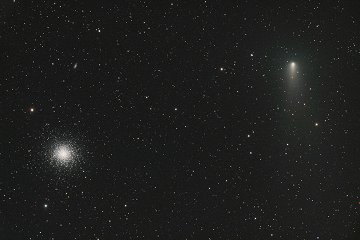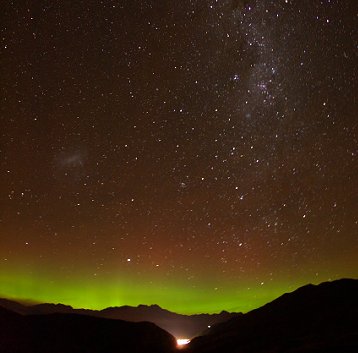METEOR SHOWER: The eta Aquarid meteor shower, caused by dust from Halley's Comet, peaks on Saturday morning, May 6th. The shower favors the southern hemisphere, where observers could see as many as 60 meteors per hour: full story.
COMET NEWS: In less than a week, dying comet 73P/Schwassmann Wachmann 3 will fly by Earth only 6 million miles away--a very close encounter. There's no danger of a collision, but the view through backyard telescopes will be magnificent. The "string of pearls" is at least 60 fragments long.
The two biggest fragments of the comet (B and C) are already visible through binoculars. Look for them high in the eastern sky just before midnight. Sky maps: May 6, May 7, May 8.
Above: Fragment B passes globular cluster M13 on May 4th. French amateur astronomer Thierry Legault took the picture using a 6-inch telescope.
Pay special attention to Fragment B. It's crumbling furiously. During the past few nights, amateur astronomers have watched the fragment splitting in two (for the second time since mid-April) and shedding debris.
Fragment B images: from Gianluca Masi of the Bellatrix Astronomical Observatory in Ceccano (FR) Italy; from Ralf Vandebergh of the Netherlands; from Paolo Candy of the Cimini Astronomical Observatory in Italy.
AURORA AUSTRALIS: "I went out to photograph Comet 73P/Schwassmann Wachmann 3 and ended up photographing auroras instead," says Minoru Yoneto of Queenstown, New Zealand. This is what he saw on the evening of May 5th:
This auroras materialized when the interplanetary magnetic field (IMF) near Earth tipped south, opening a crack in Earth's magnetic field. Solar wind poured in and fueled the display.

Potentially Hazardous Asteroids (PHAs) are space rocks larger than approximately 100m that can come closer to Earth than 0.05 AU. None of the known PHAs is on a collision course with our planet, although astronomers are finding new ones all the time.
<center> On 6 May 2006 there were 785 known Potentially
Hazardous Asteroids
</center> May 2006 Earth-asteroid encounters <table border="1" cellpadding="1" cellspacing="0" width="96%"> <tbody><tr> <td width="27%"> ASTEROID</td> <td width="19%">
<center> DATE
(UT) </center> </td> <td width="24%">
<center> MISS DISTANCE </center> </td> <td width="13%">
<center> MAG. </center> </td> <td width="17%">
<center> SIZE
</center> </td> </tr> <tr> <td> 2006 HU50</td> <td>
<center> May 4 </center> </td> <td>
<center> 3.8 LD </center> </td> <td>
<center> 17 </center> </td> <td>
<center> ~50 m </center> </td> </tr> <tr> <td> 2006 HX57</td> <td>
<center> May 6 </center> </td> <td>
<center> 3.0 LD </center> </td> <td>
<center> 16 </center> </td> <td>
<center> ~45 m </center> </td> </tr> <tr> <td> Comet 73P-C</td> <td>
<center> May 12 </center> </td> <td>
<center> 31 LD </center> </td> <td>
<center> 4 </center> </td> <td>
<center> ~1 km </center> </td> </tr> <tr> <td> 2006 GY2</td> <td>
<center> May 16 </center> </td> <td>
<center> 6.7 LD </center> </td> <td>
<center> 13+ </center> </td> <td>
<center> ~0.8 km </center> </td> </tr> </tbody> </table> Notes: LD is a "Lunar Distance." 1 LD = 384,401 km, the distance between Earth and the Moon. 1 LD also equals 0.00256 AU. MAG is the visual magnitude of the asteroid on the date of closest approach.


